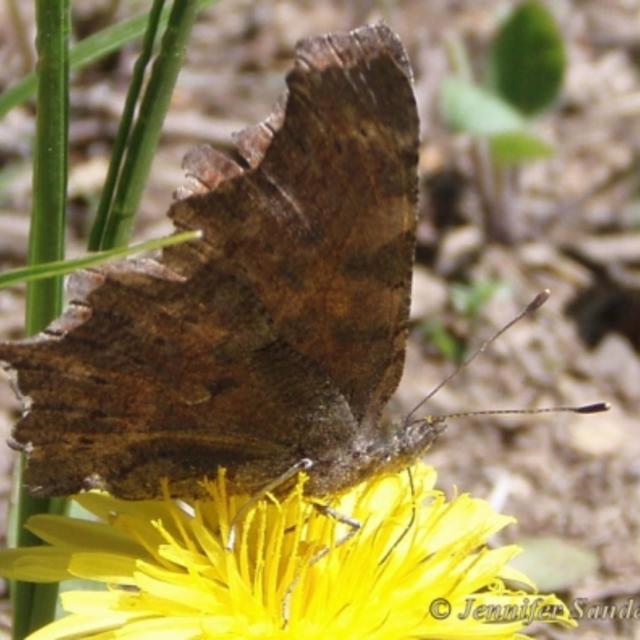Green Comma
Polygonia faunus (W.H. Edwards, 1862)
Family: Nymphalidae
Subfamily: Nymphalinae
Identification: Extremely ragged wing edges. Geographically variable. Upperside is reddish brown with wide dark borders; hindwing border contains yellow spots. Underside is brown, outer half lighter; submarginal spots are greenish; hindwing with L- or C-shaped silver spot in center.
Wing Span: 1 3/4 - 2 1/2 inches (4.5 - 6.4 cm).
Life History: In late afternoon, males perch on rocks or plants in gullies to wait for females. Eggs are laid singly on upper surface of host leaves, which caterpillars eat. Caterpillars are solitary and rest on the underside of leaves. Adults hibernate and mate the following spring.
Flight: One brood from May-August.
Caterpillar Hosts: Small pussy willow (Salix humilis), black birch (Betula lenta), alder (Alnus), western azalea (Rhododendron occidentale), and gooseberry (Ribes).
Adult Food: Flower nectar, dung, carrion.
Habitat: Forests, mountain streamsides, canyons.
Range: Boreal North America south of the tundra. Central Alaska south to central California and northern New Mexico; east across southern Canada and the Great Lakes region to New England and the Maritimes. A separate population occurs in the southern Appalachians.
Conservation: Not usually required.
NCGR: G5 - Demonstrably secure globally, though it may be quite rare in parts of its range, especially at the periphery.
Management Needs: None reported.
Please donate!
We depend on donations to keep Butterflies and Moths of North America freely available. We want to express our gratitude to all who showed their support by making a contribution this year. You can donate to support this project at any time.
Advertise with us!
Do you have a product or service that you think would interest BAMONA users? If you would like to advertise on this website, contact us by email, or use the contact form and select the "Advertising" category.
Verified Sightings
Displaying 1 - 24 of 1015 verified sightings

Observation date: Aug 24, 2007
Submitted by: hank4044
Region: Lake County, Montana, United States
Verified by: J_Martineau
Verified date: Nov 03, 2025

Observation date: May 12, 2023
Submitted by: Hank and Karen
Region: King County, Washington, United States
Verified by: davidwdroppers
Verified date: Sep 21, 2025

Observation date: May 31, 2025
Submitted by: NikkiM
Region: Carbon County, Montana, United States
Verified by: J_Martineau
Verified date: Sep 05, 2025

Observation date: Sep 01, 2025
Submitted by: NikkiM
Region: Carbon County, Montana, United States
Verified by: J_Martineau
Verified date: Sep 04, 2025

Observation date: Jun 16, 2025
Submitted by: John Terpstra
Region: Ontario, Canada
Verified by: jmgesell
Verified date: Aug 31, 2025

Observation date: Aug 12, 2025
Submitted by: John Heneghan
Region: Keweenaw County, Michigan, United States
Verified by: jwileyrains
Verified date: Aug 31, 2025

Observation date: Aug 13, 2025
Submitted by: Paul Prappas
Region: British Columbia, Canada
Verified by: Paul Prappas
Verified date: Aug 16, 2025

Observation date: Aug 06, 2025
Submitted by: Cactuswren1976
Region: Santa Fe County, New Mexico, United States
Verified by: stevecary
Verified date: Aug 09, 2025

Observation date: Jul 03, 2025
Submitted by: blgreco
Region: Archuleta County, Colorado, United States
Verified by: mikefisher
Verified date: Jul 06, 2025

Observation date: Jun 14, 2025
Submitted by: NikkiM
Region: Carbon County, Montana, United States
Verified by: J_Martineau
Verified date: Jun 23, 2025

Observation date: Jun 08, 2025
Submitted by: Anonymoose802
Region: Gallatin County, Montana, United States
Verified by: J_Martineau
Verified date: Jun 11, 2025

Observation date: Jun 02, 2025
Submitted by: hiker96
Region: Thurston County, Washington, United States
Verified by: davidwdroppers
Verified date: Jun 08, 2025

Observation date: Jun 03, 2025
Submitted by: jrmbutterfly
Region: British Columbia, Canada
Verified by: James Steen
Verified date: Jun 07, 2025

Observation date: Jun 05, 2025
Submitted by: Tom Dudones
Region: Franklin County, New York, United States
Verified by: jmgesell
Verified date: Jun 05, 2025

Observation date: Jun 05, 2025
Submitted by: Tom Dudones
Region: Franklin County, New York, United States
Verified by: jmgesell
Verified date: Jun 05, 2025

Observation date: May 29, 2025
Submitted by: Cactuswren1976
Region: Santa Fe County, New Mexico, United States
Verified by: stevecary
Verified date: May 31, 2025

Observation date: May 24, 2025
Submitted by: Cascade Colors
Region: Grand County, Colorado, United States
Verified by: mikefisher
Verified date: May 25, 2025

Observation date: May 10, 2025
Submitted by: NikkiM
Region: Stillwater County, Montana, United States
Verified by: J_Martineau
Verified date: May 12, 2025

Observation date: May 09, 2025
Submitted by: Varn
Region: Clallam County, Washington, United States
Verified by: davidwdroppers
Verified date: May 11, 2025

Observation date: Apr 28, 2025
Submitted by: david.eberly
Region: Vermont, United States
Verified by: jwileyrains
Verified date: Apr 29, 2025

Observation date: Apr 23, 2025
Submitted by: weflybye
Region: Mason County, Washington, United States
Verified by: davidwdroppers
Verified date: Apr 24, 2025

Observation date: Apr 11, 2025
Submitted by: NikkiM
Region: Stillwater County, Montana, United States
Verified by: J_Martineau
Verified date: Apr 16, 2025

Observation date: Apr 05, 2025
Submitted by: weflybye
Region: Mason County, Washington, United States
Verified by: davidwdroppers
Verified date: Apr 06, 2025

Observation date: Jun 05, 2014
Submitted by: RobSimpson
Region: Teton County, Wyoming, United States
Verified by: J_Martineau
Verified date: Mar 21, 2025
- 1 of 43
- next ›







